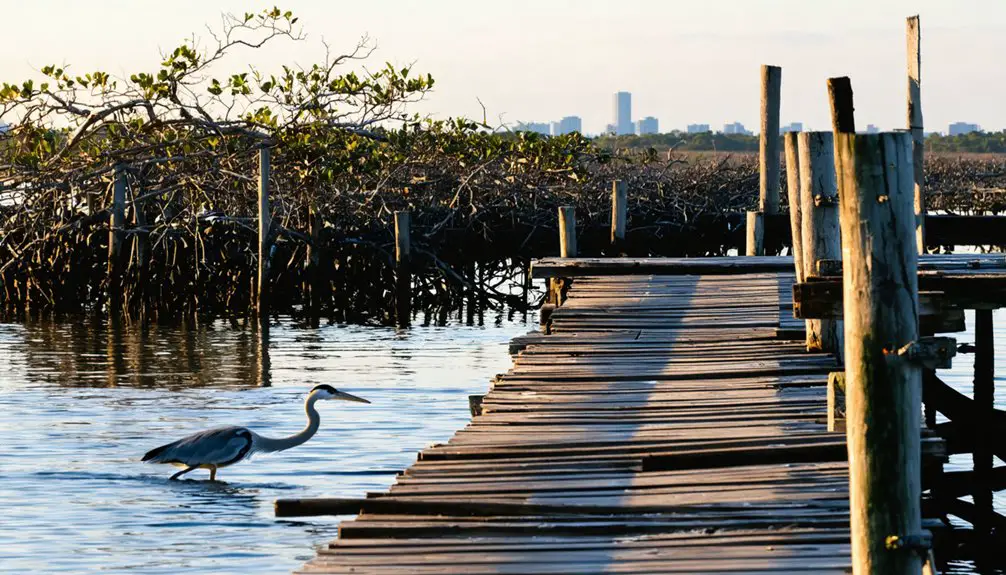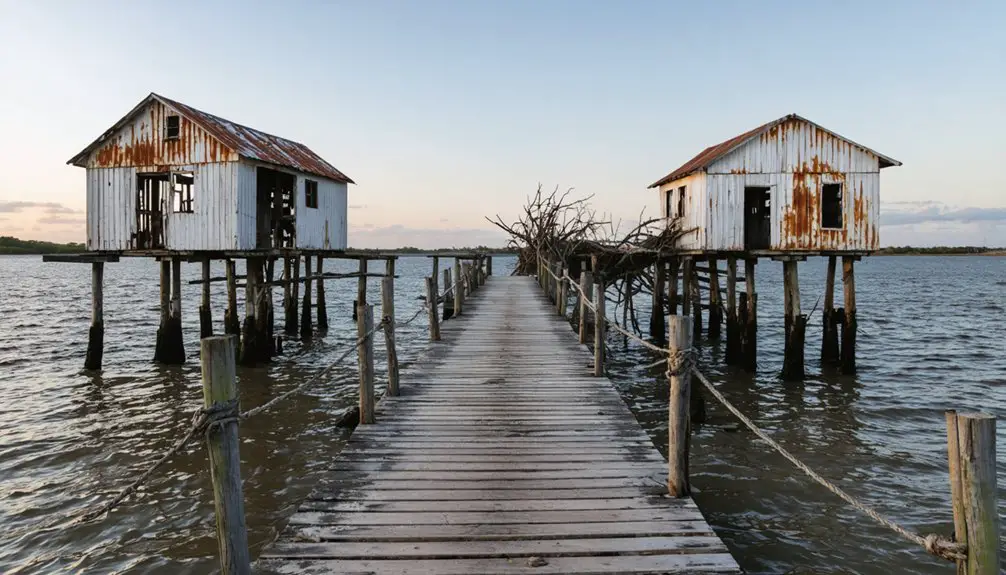You’ll find Punta Rassa’s ghost town legacy along Florida’s southwest coast, where modern condominiums now stand where a bustling cattle port once thrived. In the late 1800s, cattle barons Jacob Summerlin and Francis Hendry shipped over 1.6 million cattle to Cuba through its 800-foot pier, while the International Ocean Telegraph Company’s underwater cable connected Florida to Havana. The site’s transformation from Native American settlement to military fort to cattle empire holds fascinating tales of Florida’s frontier past.
Key Takeaways
- Punta Rassa transformed from a bustling cattle-shipping port into a modern area dominated by toll plazas and condominiums.
- Historic structures like Fort Dulany, Summerlin House, and the telegraph station no longer exist at their original locations.
- The settlement’s decline began after its peak as a major cattle-shipping hub that exported 1.6 million cattle to Cuba.
- Former economic drivers, including the cattle trade and telegraph operations, have completely disappeared from the modern landscape.
- The original Native American settlements and military fortifications were gradually replaced, leaving minimal traces of historical infrastructure.
Ancient Origins and Native American Heritage
Four distinct Native American civilizations left their mark on Punta Rassa, with human habitation dating back an astounding 10,000 years.
The Calusa civilization emerged as the dominant force around 2,500 years ago, establishing a powerful warrior society that controlled vast stretches of Southwest Florida’s coastline. Like their settlements on nearby islands, they developed extensive canal systems that facilitated transportation and trade throughout the region.
The fierce Calusa warriors rose to power 2,500 years ago, dominating Florida’s southwestern shores with unrivaled strength and sophistication.
You’ll find evidence of their sophisticated culture in the remains of fish houses and drying sheds near the bays. The Calusa civilization mastered Indigenous trade networks and maintained complex chiefdom structures rare among Florida tribes.
They fiercely defended their territory, earning the nickname “Vikings of Florida.” At Punta Rassa, which they called the “Point of Swift Waters,” they built thriving communities based on fishing and shellfish gathering. In 1521, Ponce de Leon named the area, marking the first European contact with this ancient settlement.
Their presence endured until the late 1700s, shaping the region’s character for generations.
Military Fortifications and Strategic Role
The strategic significance of Punta Rassa took a military turn in 1838 with the construction of Fort Dulany during the Second Seminole War. The fort’s military architecture served as an essential supply depot, controlling Seminole movements while supporting operations at nearby Fort Myers.
After a devastating hurricane destroyed the original fort in 1841, you’ll find that its coastal defense role proved too significant to abandon. The military rebuilt Fort Dulany during the Third Seminole War, and it later served as a pivotal Union stronghold during the Civil War. Local cattle baron Jacob Summerlin drove his herds through this area to ship them to Cuba.
Union forces used it to disrupt Confederate cattle supplies and maintain blockade operations. Both forts were completely abandoned after the Civil War ended.
The site’s strategic value evolved when the International Ocean Telegraph Company established a station there in 1866, transforming Punta Rassa into a critical communication hub during the Spanish-American War.
The Rise of the Cattle Empire
You’ll find the story of Punta Rassa’s cattle empire dominated by powerhouse figures like Jacob Summerlin, who shipped over 1.6 million cattle to Cuba between 1874 and 1883, and Francis Asbury Hendry, who helped expand the region’s livestock operations with his 12,000-strong herd.
The port’s strategic location made it the perfect hub for cattle shipments to Cuba, with Summerlin and his partners constructing an 800-foot pier, expansive holding pens, and other essential infrastructure to support the booming trade. Known for his exceptional skills in handling cattle, Summerlin established innovative practices that revolutionized the industry’s operations.
The “King of the Crackers” and his fellow cattle barons transformed Punta Rassa from a modest port into a thriving commercial center, where Cuban gold flowed freely in exchange for Florida beef. The International Ocean Telegraph company managed shipping operations and dock facilities, further solidifying Punta Rassa’s position as a vital trade hub.
Cattle Kings Take Control
During Florida’s post-Civil War era, cattle barons Jacob Summerlin and Francis Asbury Hendry transformed Punta Rassa into a thriving cattle empire.
You’ll find their cattle barons’ influence extended far beyond the massive holding pens they built at the port. As former Confederate soldiers, they’d leveraged their military connections and experience to dominate the region’s economic landscape.
Summerlin and his brother established vital trade routes to Cuba, while Hendry, a former Cow Cavalry commander, expanded his operations across Southwest Florida. Summerlin’s insistence on payment in gold during the war years proved especially lucrative for his business ventures.
Their economic impact reshaped the region as they shipped thousands of cattle through Punta Rassa’s port facilities.
These savvy businessmen didn’t just control the cattle trade; they wielded significant political power, with Hendry helping establish Lee County and Summerlin advocating for moving Florida’s capital to Orlando.
Shipping Profits Surge
As Punta Rassa’s cattle empire flourished in the 1870s, the port’s strategic location helped secure its dominance in Florida’s livestock trade, handling an impressive 18,000 of the state’s 21,000 cattle exports to Cuba. The heritage of these cattle operations traced back to Spanish Conquistadors who first established ranching in the region during the 1500s.
You’d find a bustling cattle economy that had grown dramatically from its early days, with annual shipments reaching 30,000 head by 1840. The shipping logistics were remarkable – drives of 300-400 steers traveled up to 300 miles to reach the port, while larger operations moved herds of 1,500 cattle with just ten cowboys.
After the Civil War’s disruptions, trade expanded beyond Cuba to include Savannah and Charleston. The port’s success generated substantial wealth for influential families like the Summerlins and Hendrys, who invested in extensive stockyards and shipping infrastructure that transformed Punta Rassa into Southwest Florida’s commercial powerhouse. The earliest documented livestock movement through the area occurred when P. B. Prior conducted the first cattle drive in 1833.
Life at Summerlin House
Life at the bustling Summerlin House reflected the dynamic nature of Punta Rassa’s cattle trade era. You’d find hunters, drovers, ranchers, and Cuban cattle buyers mingling in this two-story wooden hotel, conducting business and forging connections that shaped Florida’s economy.
When every room was taken, cowboys would make camp beneath the building, demonstrating their resourcefulness and dedication to the trade.
The hotel’s strategic location near the cattle pens and wharves made it the heart of local commerce. You could witness deals being struck as cattle valued at millions of dollars moved through Punta Rassa’s port bound for Cuba.
The surrounding wooden buildings, including bars and merchants, created a lively atmosphere where cattlemen could find respite after long days moving livestock.
Telegraph Station: Florida’s Link to Cuba

You’ll find Punta Rassa’s most essential contribution to history in its telegraph station, established by the International Ocean Telegraph Company in 1866 as Florida’s important communication link to Cuba.
The station’s strategic value peaked during the Spanish-American War of 1898, when it served as the fastest route for military intelligence and updates between the U.S. mainland and Cuban forces.
Operating from a converted military barracks built on fourteen-foot pilings, the station managed an underwater cable system that revolutionized communication speed between Florida and the Caribbean. The area’s maritime significance was enhanced by its busy steamship wharf activities throughout the 1890s.
Strategic Location Importance
Punta Rassa’s strategic significance emerged in the 1860s when the International Ocean Cable Company installed an underwater telegraph cable connecting Florida to Havana, Cuba.
You’ll find this 110-mile undersea link served as a essential communication hub, particularly during times of mounting tension between the U.S. and Spain.
The station’s position proved critical during the Spanish-American War, as you’d have witnessed urgent messages about the USS Maine explosion and other wartime intelligence flowing through its lines.
This strategic alliance between Punta Rassa and Cuba created a direct path for communication advancements that shaped military operations and political decisions.
When messages reached Florida’s shores, they’d quickly transmit northward through Punta Rassa’s connection to Lake City, integrating important Cuban intelligence into America’s broader telegraph network.
War Updates Via Telegraph
Stationed inside the repurposed “Tarpon House,” telegraph operators at Punta Rassa‘s International Ocean Telegraph Company facility worked around the clock to relay critical wartime messages between Cuba and the United States.
You’ll find that telegraph technology played an essential role during the Spanish-American War, though contrary to popular belief, Key West received the USS Maine explosion news first, with Punta Rassa serving as a significant relay point northward.
The station’s military communication capabilities supported U.S. naval forces and diplomatic responses throughout periods of conflict. Operating from their fourteen-foot elevated perch, dedicated operators like George Shultz managed continuous transmissions while “trouble shooters” stood ready to repair any line breaks.
This strategic communication hub remained active through increased military operations until wartime telegraph needs diminished.
A Bustling Port Town’s Daily Life
The bustling port town of Punta Rassa came alive each day with the thundering hooves of cattle and the shouts of cowboys driving their herds toward the wharves.
In your daily routines, you’d find merchants opening their wooden storefronts, Cuban cattle buyers negotiating deals, and cowboys loading cattle at 10-15 cents per head.
Community interactions centered around the Summerlin House hotel, where you’d meet drovers, ranchers, and international traders sharing stories over drinks at the local bars.
When the hotel filled up, cowboys would make camp beneath it, creating an impromptu gathering space.
The port’s dynamic culture blended American cattlemen, Cuban businessmen, and telegraph operators, all contributing to the vibrant atmosphere of this vital shipping hub.
The Vanishing Settlement’s Modern Legacy

While daily life in old Punta Rassa revolved around cattle and commerce, modern visitors will find a dramatically different landscape shaped by its rich historical legacy.
Where cowboys once camped and telegraph operators relayed essential messages, you’ll now see toll plazas, hotels, and condominiums.
Despite this economic decline as a shipping port, Punta Rassa’s cultural heritage lives on through its multiple historical roles: a strategic military outpost during the Seminole and Civil Wars, a significant telegraph station connecting Florida to Cuba, and a thriving cattle-shipping hub.
From military outpost to telegraph station to cattle port, Punta Rassa’s diverse roles shaped Florida’s journey to statehood.
The site of Fort Dulaney, Summerlin House, and the International Ocean Telegraph Company station may have vanished, but these landmarks represent pivotal moments in Florida’s development from frontier territory to modern state.
Frequently Asked Questions
What Happened to the Native American Artifacts Found in Punta Rassa?
You’ll find most artifacts preserved in regional museums, where they maintain archaeological significance through scientific study, while some remain protected at sites like Bowditch Point Park and Mound Key Archaeological State Park.
How Much Did Cattle Ranchers Typically Earn During Punta Rassa’s Peak Years?
Like golden rivers flowing into their pockets, you’d have earned substantial cattle profits during the 1840-1870s peak, with top ranchers making thousands in Spanish doubloons per 30,000-head annual shipment.
Were There Any Notable Shipwrecks Near Punta Rassa’s Harbor?
You’ll find compelling shipwreck stories about the steamship Alicia, which struck a reef and became a permanent fixture. Maritime legends also tell of salvage conflicts that required the Revenue Cutter Bear’s intervention.
What Natural Disasters Impacted Punta Rassa Besides the Fort-Destroying Hurricane?
Like a relentless hammer, nature pounded your coastal settlement repeatedly. You’d have faced Hurricane Ian’s devastating surge in 2022, the 1928 Okeechobee storm’s destruction, and numerous flooding events since 1873.
Did Any Famous Outlaws or Criminals Operate in Punta Rassa?
You won’t find records of famous outlaws or notorious criminals specifically tied to Punta Rassa, though the area experienced general lawlessness typical of Florida’s frontier during its early settlement period.
References
- https://floridacrackercrumbs.wordpress.com/2008/05/31/cracker-cowmen-the-history-of-punta-rassa/
- https://www.atlasobscura.com/places/punta-rassa-telegraph-station
- https://en.wikipedia.org/wiki/Punta_Rassa
- https://shtca.mycommunitysite.co/our-history
- https://puntarassa.org/History
- https://islandinnsanibel.com/sanibel-island-history/
- https://www.resortharbourproperties.com/punta-rassa-history/
- https://downtownfortmyers.com/the-history-of-fort-myers/
- https://frontier-florida.blogspot.com/2024/01/punta-rassa-small-size-big-history.html
- https://www.gulfshorebusiness.com/backstory-cattles-role-in-punta-rassas-history/



